Landscaping in Garden Fencing
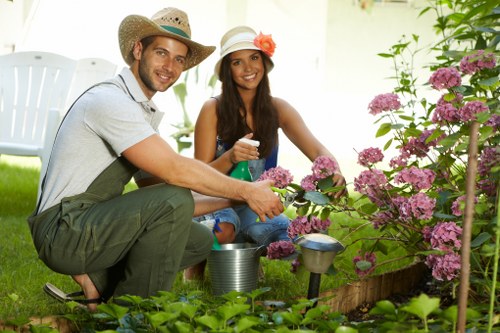
Landscaping in garden fencing is a pivotal aspect of creating an aesthetically pleasing and functional outdoor space. By integrating fencing with thoughtful landscaping, homeowners can enhance privacy, security, and the overall visual appeal of their gardens. This harmonious blend not only defines boundaries but also serves as a backdrop for various plantings and garden features.
When planning your garden fencing, it's essential to consider the style of your home and the existing landscape. Whether you prefer a rustic wooden fence or a sleek metal design, the right fencing can complement your garden's theme and elevate its beauty. Moreover, strategic landscaping around your fence can soften its appearance and create a seamless transition between cultivated and natural areas.
One of the primary benefits of incorporating landscaping with garden fencing is the added privacy it provides. Tall hedges, climbing plants, or decorative panels can obscure views from neighboring properties, allowing you to enjoy your garden in peace. Additionally, well-designed fencing can act as a barrier against noise and pests, creating a more serene and comfortable outdoor environment.
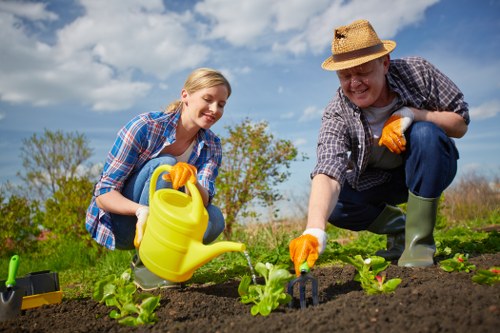
Choosing the Right Fencing Material
Selecting the appropriate fencing material is crucial for both functionality and aesthetics. Popular options include wood, vinyl, metal, and composite materials, each offering unique advantages. Wood fences, for instance, provide a classic and natural look, while metal fences like wrought iron add a touch of elegance and durability.
Vinyl fencing is another excellent choice, known for its low maintenance and versatility. It can mimic the appearance of wood without the susceptibility to rot or insects. Composite fencing, which combines wood fibers and plastic, offers the best of both worlds with enhanced strength and weather resistance.
When selecting your fencing material, consider the climate of your region, the level of maintenance you're willing to undertake, and the overall design of your garden. Investing in high-quality materials will ensure that your fence remains attractive and functional for years to come.
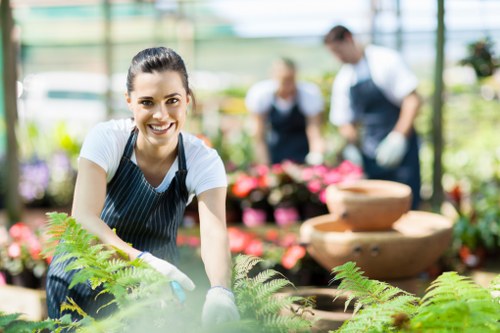
Integrating Plants with Garden Fencing
Climbing Plants and Vines
One effective way to blend landscaping with garden fencing is by incorporating climbing plants and vines. These greenery options can transform a plain fence into a living art piece, adding texture and color to your garden.
Clematis and ivy are popular choices for climbing on fences. Clematis offers a variety of vibrant flowers that can brighten up your outdoor space, while ivy provides lush, evergreen coverage that enhances privacy year-round.
Planting climbing species not only beautifies your fence but also creates a natural habitat for birds and insects, promoting biodiversity in your garden. Ensure you choose plants that are well-suited to your climate and the specific conditions of your garden, such as sunlight and soil type.
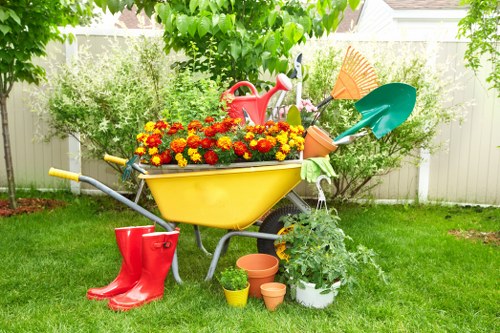
Vertical Gardens
Vertical gardens are another innovative way to integrate landscaping with garden fencing. By utilizing vertical space, you can maximize your planting area without sacrificing ground space. This approach is particularly beneficial for smaller gardens where space is limited.
Installing vertical planters or trellises on your fence allows you to grow a variety of plants, including herbs, succulents, and flowers. This not only enhances the visual appeal of your fence but also provides easy access to fresh herbs for cooking or beautiful blooms for decoration.
Vertical gardens require thoughtful planning and regular maintenance to ensure the health of the plants. Proper irrigation and nutrient management are essential for sustaining a thriving vertical garden, making it a rewarding addition to your landscaped fence.
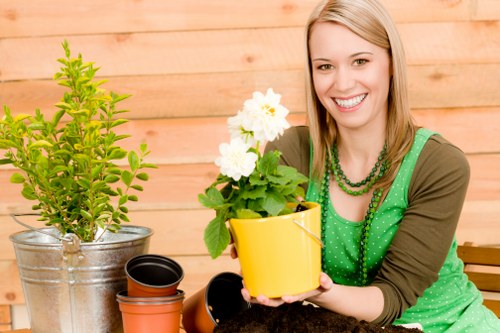
Maintenance and Care for Fenced Gardens
Regular Maintenance Tips
Maintaining your garden fencing and surrounding landscaping is key to preserving the beauty and functionality of your outdoor space. Regular upkeep ensures that your fence remains sturdy and that the plants integrated with it stay healthy.
- Inspect your fence regularly for any signs of damage or wear. Look for loose boards, rust on metal fences, or rot in wooden structures.
- Clean your fence to remove dirt, debris, and mildew. This can be done using a hose, mild soap, and a brush.
- Prune plants growing on your fence to prevent overgrowth and maintain the desired shape and size.
- Protect your fence from the elements by applying appropriate sealants or paints, especially for wood and metal fences.
By following these maintenance practices, you can extend the lifespan of your garden fencing and ensure that your landscaped elements continue to thrive and enhance your garden's appeal.
Pest and Disease Management
Pests and diseases can pose significant challenges to both your fencing and landscaping. It's important to monitor your plants and fence for any signs of infestation or damage to address issues promptly.
- Identify the problem by regularly inspecting plants and fencing for pests like aphids, slugs, or beetles, and signs of diseases such as mold or discoloration.
- Implement control measures, such as using organic pesticides, introducing beneficial insects, or removing affected plant parts.
- Maintain good garden hygiene by clearing fallen leaves, debris, and any dead plant material that can harbor pests and diseases.
Proactive pest and disease management protects the integrity of your garden fencing and ensures that your landscaped elements remain healthy and vibrant.
Enhancing Privacy with Landscaping
Privacy is a common desire for many garden owners, and landscaping plays a crucial role in achieving it alongside garden fencing. By carefully selecting and positioning plants, you can create secluded areas within your garden.
Hedgerows of shrubs or bushes can be planted along the fence line to act as natural screens. Species like boxwood, privet, or holly are excellent choices for creating dense barriers that block unwanted views.
Layering different types of plants adds depth and enhances the effectiveness of your privacy screen. Combining evergreen and deciduous plants ensures year-round coverage and a dynamic appearance throughout the seasons.
Decorative Elements and Accessories
Incorporating decorative elements and accessories can elevate the look of your garden fencing and landscape. Features such as lighting, ornaments, and seating areas add both functionality and charm to your outdoor space.
- Outdoor lighting along the fence can highlight architectural details and provide safety during evening hours.
- Decorative panels or artistic accents can make your fencing a focal point of your garden.
- Seating areas, such as benches or swings attached to the fence, offer inviting spots to relax and enjoy your landscaped garden.
These enhancements not only improve the aesthetic appeal of your garden but also create a more enjoyable and personalized outdoor environment.
Sustainable Landscaping Practices
Embracing sustainable landscaping practices ensures that your garden fencing and landscaping efforts are environmentally friendly and resource-efficient. Sustainable methods promote the health of your garden while reducing your ecological footprint.
Choosing native plants that are well-adapted to your local climate minimizes the need for excessive watering and maintenance. Native species also support local wildlife and biodiversity.
Water-efficient irrigation systems, such as drip irrigation or rainwater harvesting, help conserve water and provide your plants with the necessary moisture without waste.
Seasonal Landscaping Considerations
Each season brings unique opportunities and challenges for landscaping in garden fencing. Adapting your approach to suit the seasonal changes ensures that your garden remains beautiful and functional year-round.
Spring
Spring is the perfect time to plant new shrubs or flowers along your fence. As plants begin to grow, they add vibrant colors and fresh foliage to your garden.
Summer
During the summer months, focus on maintaining your plants through regular watering and pruning. Consider adding shade elements to protect both your plants and your outdoor living spaces from intense sunlight.
Autumn
Autumn offers an opportunity to clean up fallen leaves and prepare your garden for the winter. Planting hardy perennials can ensure that your fence remains lush even during the colder months.
Winter
In winter, protect your fencing from harsh weather by applying sealants. Use evergreen plants to maintain greenery, and consider adding ornaments or lights to keep your garden inviting.
Incorporating Functional Features
Beyond aesthetics, incorporating functional features into your landscaped garden fencing can enhance the usability of your outdoor space. Practical additions like gates, trellises, and storage solutions contribute to a well-rounded garden design.
Gates provide convenient access to your garden while maintaining security and privacy. Choosing a gate style that matches your fence ensures a cohesive look.
Trellises attached to your fence serve as supports for climbing plants and can also define specific garden areas or pathways.
Cost Considerations and Budgeting
Landscaping in garden fencing can vary widely in cost, depending on the materials, plants, and features you choose. Proper budgeting ensures that your project is financially feasible and meets your design goals.
- Material costs vary based on the type and quality of fencing. Wood tends to be more affordable, while metal and composite materials may require a larger investment.
- Plant selection affects both initial and ongoing costs. Native and perennials may offer long-term savings through reduced maintenance.
- Labor expenses should be factored in if you're hiring professionals for installation and maintenance.
Creating a detailed budget before starting your landscaping project helps you allocate resources effectively and avoid unexpected expenses.
DIY vs. Professional Installation
Deciding whether to undertake your landscaping and fencing project yourself or hire professionals depends on your skills, time, and budget. DIY projects can save money and offer personal satisfaction, while professional installation ensures expertise and high-quality results.
- Assess your skills and determine if you have the necessary tools and knowledge to complete the project effectively.
- Consider the time commitment required for planning, purchasing materials, and performing the work.
- Compare costs of doing it yourself versus hiring professionals to determine the most cost-effective approach.
Whether you choose a DIY path or seek professional help, careful planning and consideration are key to a successful landscaping and fencing project.
Final Thoughts on Landscaping in Garden Fencing
Landscaping in garden fencing is a transformative practice that enhances both the beauty and functionality of your outdoor space. By thoughtfully selecting materials, integrating plants, and incorporating functional and decorative elements, you can create a garden that reflects your personal style and meets your practical needs.
Remember to consider sustainable practices and seasonal changes to maintain a healthy and vibrant garden throughout the year. Regular maintenance and mindful planning will ensure that your landscaped fence remains a stunning feature of your home for years to come.
Ready to transform your garden? Contact us today to book your landscaping service and take the first step towards a beautiful and functional outdoor space.